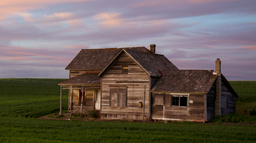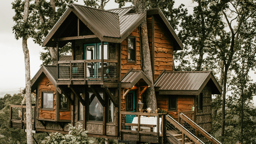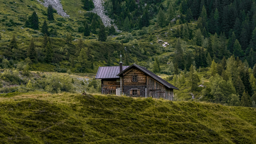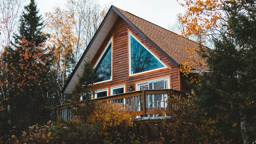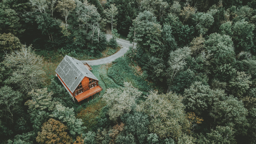Remote getaways that are visited only seasonally can be ideal targets for potential thieves. The good news is that a would-be burglar’s biggest deterrents are light, noise, and barriers to effortless entry – obstacles that are relatively inexpensive and simple to create at your cabin. Pair these with some common-sense strategies, and you can rest easy knowing your retreat is safe and sound while you’re away.


Doors
Most cabin and cottage owners can make their places more secure by making a few simple changes to their doors. Here's where to start.
Check Your Striker Plate and Replace Those Screws
Cabin owners should start by inspecting their doors. Most front doors have a deadbolt lock with a striker plate on the opposite side of the deadbolt. The striker plate (or “strike reinforce”) is a critical link to the locking system.
“If the bolt is just going into the jamb, it won’t take much to kick in the door,” says Mike Holman, Senior Product Manager for Schlage Residential Security Products. “That strike reinforce, however, significantly increases the kick-in resistance.”
Still, it is not enough to have a striker plate installed; it needs to be installed using the proper hardware. Too often, small 5/8-inch screws are used to screw the deadbolt striker plate in place, but they do not reach deep enough into the wood to remain secure. As a result, an intruder can kick in the door with very little effort. Homeowners replace those small screws with 3- to 4-inch screws that go down deep into the wood and grip stronger
Flip Lock
If an exterior door has glass near it, a burglar simply has to break the glass, reach in, and unlock the deadbolt. So for glass doors, consider a flip lock, which is longer than the deadbolt striker plate and can be flipped around to allow the door to open normally. When the plate is flipped back and drops into the slot of the plate, the door will not open.
Protecting Doors
When it comes to sliding doors, Detective Lieutenant Tim Cook of the Cheboygan (Mich.) County Sheriff Department suggests that cabin owners use security glass and secure the bottom portion of the door with a pole so that it cannot open.
For side or back entry doors on garages, Cook has another suggestion. “If possible, have a metal or wood latch system the size of a 2x4 that goes across the inside of your door,” says Cook. “[This way, if it is] kicked, it will not break.”
Oh, and Don't Forget About Keys
Those fake rocks and other novelties for hiding keys? Yeah, burglars know to look for those too. Consider using a lockbox for spare keys instead; you can change the code on the lockbox as often as you need.

Windows
Pin Those Windows
As for windows, Cook recommends that cabin owners use dowels or pins in the frame of the window so that it cannot open completely.
Back-up Locks
Auxiliary window locks are also a great option. If you look at your window, the top half stays fixed in place while the bottom half slides up and down inside a track formed by a little lip of metal, which extends out from the wood or sheetrock around the window frame. An auxiliary window lock is a small U-shaped clamp with a tightening screw that slides onto the lip of metal, right above the bottom portion of the window when the window is in the locked down position. The clamp is screwed down until it secures the device, and the window cannot be raised even if the regular window locks are open.
Alarms
Create the potential for noise with battery-powered stick-on window alarms; an alarm sounds if the sensor is separated from the power source when someone slides the window open. These gadgets also work well on sliding doors.
Landscaping Near Windows
Keep bushes and trees trimmed so the views of your windows and doors aren’t obstructed. That way, burglars can’t hide near these entry points and your neighbors will be able to see any suspicious activity.

Lights
Even if you’ve installed outdoor lighting for aesthetics (and have timers set up to turn on the lights while you’re away), consider adding motion-sensor lights to any areas the standard lights don’t reach.
Set up timers on indoor lights so they randomly turn on at night. Periodically switch the timers to different lamps and rooms so your initial “random” setup doesn’t form a pattern.
Create a Lived-in Look
Draw the blinds to make sure valuables like TVs, stereos, jewelry, guns, liquor, artwork, etc. aren’t visible. Don’t be too uniform about it, though; try to maintain a lived-in appearance rather than a “closed up for the next few months” look.
Keep up with maintenance. Ask a neighbor or hire a lawn service to mow, rake, shovel, etc. You want your place to look lived in.

Keep an Eye on Your Cabin, Even From Afar
Besides making your property less attractive to sneaky thieves by removing valuables, installing better locks, and adding lots of lights, another way to increase security is to install cameras around the outside of the cabin to capture any suspicious action while you’re away.
The images will provide you with evidence (should you need it) and alert you to potential gaps in your cabin security. High-tech surveillance systems are nice, but webcams and trail cameras can be less expensive alternatives and as technology evolves, offer more and more features.
Webcams
These cameras are small and inconspicuous, and the most basic models are widely available at affordable prices. Set up multiple cameras around your property, then connect them (using cables or Wi-Fi or even LTE cellular) to a computer inside the cabin. The photos taken by the camera are automatically saved to your hard drive or send to an app, allowing you to access them from any computer or smartphone.
Adding an appropriate app or other security software (high-end cameras often come with their own) will allow you to further manipulate your DIY system. Some let you define what types of motion to record (you want to know every time a window or door opens, but you probably don’t need to see each frame of a squirrel scampering past). You may also be able to receive notifications of any activity via email or text message, and program your device to emit a criminal-deterring sound if triggered.
Trail Cameras
If you have neither a computer nor internet/cellular service at your cabin, another surveillance option to consider is a motion-activated trail camera. Hunters and wildlife photographers often use them to monitor animal activity. But many people have found that these weather-resistant, discreet cameras are also well-suited for security purposes.
Trail cameras take digital photos and sometimes videos of movement, storing the images to a memory card inside the box. They are typically battery powered, but some offer solar-power options or may be connected to your cabin’s electrical current for long-term operation. Most also include no-flash, infrared technology for capturing images in the dark.
You can opt for a very basic trail camera for less than $100, but there are also more expensive models that takes high-definition images at speeds as fast as three frames per second and can capture license plates of vehicles moving as fast as 50 miles per hour, even at night. With models like that, you can schedule when you want the camera to be on or off, so you don’t have to manually shut it off when you visit the cabin on the weekend.
Learn more about cabin safety and security here.




